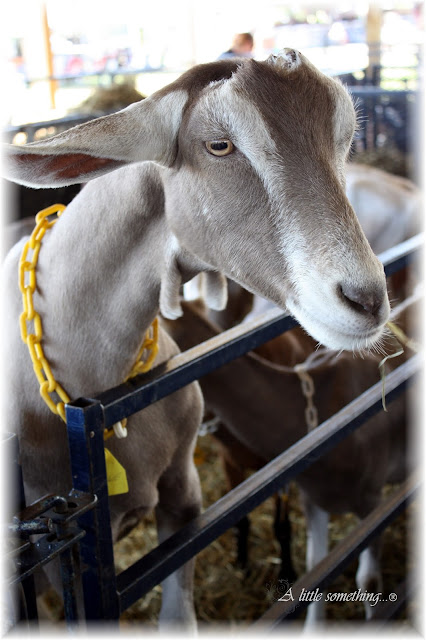USA today...
 When colorful livestock, dancing tractors, diving dogs, woodcarvers, a Dixie Band and racing pigs are part of a grand assembly, it can only mean the county fair is in town. Driving up to Rhinebeck, NY for the annual Dutchess County Fair, we couldn't have asked for better weather to enjoy this American tradition. A nice breeze, lots of sunshine and a sea of people covered the Fairgrounds. This was a first for us, and we were not disappointed! Though so cliche, there was something for everyone here, whether you love food, unusual attractions, animals, arts & crafts, or music. Walking the whole day (almost eight hours) from one area to the next, we made sure not to miss any of the fun. Brenna and I had a personality analysis of our handwriting, Robert pet a chicken, and we were raised to new heights on the Ferris wheel.
When colorful livestock, dancing tractors, diving dogs, woodcarvers, a Dixie Band and racing pigs are part of a grand assembly, it can only mean the county fair is in town. Driving up to Rhinebeck, NY for the annual Dutchess County Fair, we couldn't have asked for better weather to enjoy this American tradition. A nice breeze, lots of sunshine and a sea of people covered the Fairgrounds. This was a first for us, and we were not disappointed! Though so cliche, there was something for everyone here, whether you love food, unusual attractions, animals, arts & crafts, or music. Walking the whole day (almost eight hours) from one area to the next, we made sure not to miss any of the fun. Brenna and I had a personality analysis of our handwriting, Robert pet a chicken, and we were raised to new heights on the Ferris wheel.Brenna flew around the sky on the reminiscent ornate swings. There were many rides for all types from the daredevil to the docile, with a whole section in Kiddie Land suited for little children to enjoy.
Engrossed with the retrospective Century Museum Antique Village, we browsed vignettes moderated by volunteer docents ready to answer questions about everyday life in 1913. The auto front and center set the mood as we entered.
Time stood still as we watched the craftsmen working in each setting.
Chair caning was a popular craft at the time and required much patience and diligence. Each seat had a thread of cane woven vertical, horizontal and two diagonal for ultimate seat support. That's tedious work!
There were some canned and packaged goods in the country store still on the shelves today - we spotted Jello!
Here, the docent demonstrated various knitting techniques used which was a great way to incorporate the wool buzzed off in the Sheep Pavilion.
Out on the Texas Roadhouse Grandstand, these were the Dancing Diggers. Now, we never saw power tractors maneuvered like this before! And choreographed to music! You can check out their YouTube video.
After the power display, the XPOGO Stunt Team jumped into their own high-powered show of stamina on super hydrolic pogo sticks, flipping in the air, swinging around in stunts that seemed effortless. It was quite a show!
Lots of the animals were allowed to be pet and even fed. They were gentle and calm, as long as you handled them with care. We saw goats, sheep, cows, horses, pigs and even llamas.
Much beauty to behold in the number of different color and pattern feather variations of the chickens.
In the Horticulture building, numerous winning floral and landscape displays encompassed a variety of themes, like this replicated Kingston Rhinecliff Bridge of lights and winter greenery.
A hand-carved wood bench with detailed owl family perched here - one of the many crafts on display for sale putting artisans in the spotlight.
Our guide, Victor, was very knowledgeable about FDR's life history, with anecdotes about his character and enlightening personal traits as President and man of the times.
This bronze statue embodies Eleanor and Franklin in a jovial moment as you enter the Henry A. Wallace Visitor and Education Center. The cafe offers a tasty menu of light luncheon items we enjoyed out on the terrace.
Laid all in mosaic, this map is centrally located on the floor of the Education building. All the domiciles of the Springwood estate are pictured on this vast work of art for all visitors to admire.
Young FDR in bronze sits in the main hall, majestically greeting us as we enter his home.
The library where Roosevelt spent much time.
The formal parlor.
Throughout the house are personal artifacts, many hand-made pieces adding to the intimate surroundings.
In the garden, the floral color display was rich, even at the end of August, with the carriage house in the distance. Franklin and Eleanor are both buried on the grounds, a request to return home once the time came.
We visited the Presidential Library where the displays take you through FDR's presidency, the lives of the Roosevelts, the Great Depression, the New Deal and World War II. Though I am not a big fan of history, the library's interactive exhibits made the learning journey fun, filled with personal memorabilia and authentic audio and visual components, encouraging you to look, listen and learn.
Brenna listened to Roosevelt speak to the nation in one of his many fireside chats here in the Map Room over the rotary phone.
His desk is behind glass, all in tact as if he were about to re-enter and get back to work. Around, the glass walls are etched with the Four Freedoms he articulated for us as a nation.
Surrounded by the items most dear to him, Roosevelt believed, "the dedication of a library is in itself an act of faith... A nation must believe, in the capacity of its own people, to learn from the past that they can gain in judgement in creating their own future."





























0 comments